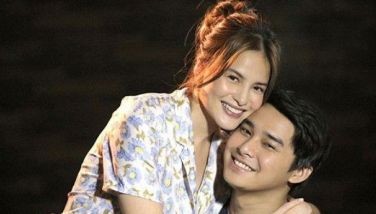Yoko’s most influential artwork – the Beatles
MANILA, Philippines - Yoko Ono’s 40-year retrospective of conceptual art is titled Yoko Ono Half-a-Wind Show. Retrospective opened at the Guggenheim Museum in Bilbao, Basque Country, Spain on March 14 and will run until Sept. 1. But the exhibit misses her most influential artwork the Beatles.
Declaring “the only thing we can do to make something worthwhile is to do something else,†Ono’s conceptual art thrived on originality that contrasted with the Beatles’ art of derivation. A film by her was described as “the cinema’s nearest equivalent to certain pieces of Bach.â€
The Beatles’ art of song depended largely on the personality John Lennon idolized. Lennon had always needed a new source of inspiration to give him the imagination to be creative.
Lennon met the diminutive Japanese artist upon previewing her exhibit of conceptual art of half household objects titled Half-A-Room at the Indica Gallery in 1967. This included Ceiling Painting that made Lennon climb a ladder to read with a magnifying glass a small “Yes†on a suspended board. These exhibits are at the Guggenheim show.
By introducing him to her conceptual art and through heroin, Ono blew Lennon’s mind and led to him to accept her not only as a lover, but also as an artistic collaborator. She turned out to be his new source of imagination.
When Lennon sent his wife Cynthia to a Greek holiday with friends, he invited Ono to their Weybridge House, determined to pursue her. After he had shown her his tape loop experiments, she prodded him for them to produce electronic music. After the sound collage experiment produced the Unfinished Music No. 1: Two Virgins album, they made love to consummate their relationship.
Without explanation, Lennon brought Ono into the control room of Studio Three of Abbey Road at the beginning of the recording sessions of Revolution. He quickly introduced her to everyone and she thereafter never left his side.
When the Beatles created Apple Corps. Paul McCartney got the company name “Apple†from George Harrison’s favorite Granny Smith variety. But Ono inspired the logo of vinyl records (45 rpm, EP, and album) based on her Half-A-Room exhibit that included an apple cut into half. They have the full apple logo on the A-side and the cut fruit on the B-side.
Originally titled Hey Jules after Lennon’s son by Cynthia, Julian, McCartney wrote Hey Jude to console him when his father fell in love and started living with Ono. The last quarter of 1968 was troubling for Lennon. Cynthia won the divorce suit she filed against him on grounds of adultery.
Ono also suffered a miscarriage. Both Lennon and Ono were taken into police custody for cannabis possession, which Lennon owned up to in order to extricate Ono from responsibility. Lennon’s monotone recitation in I’ve Got A Feeling reflects these difficult circumstances.
The initial high of Lennon’s relationship with Ono surfaced in The Beatles album, otherwise known as The White Album for its stark white cover, a mark of Ono’s minimalist style. She wore all-white (or all-black) attires which Lennon had copied by then.
Ono sang, “Not when he looked so fierce,†the first female vocals in a Beatles song, in The Continuing Story of Bungalow Bill.
The second part of Happiness Is a Warm Gun about needing a fix is about Ono introducing Lennon to cocaine in the summer of 1968.
Lennon refers to Ono in I’m So Tired in the lines “My mind is set on you,†confirming Lennon’s decision to continue his extra-marital relationship with her.
Julia is a solo Lennon recording, the first time he did it as a Beatle. It is a tribute to the two important women in his life. Although Lennon made it appear like it was only about his mother Julia, it was very much about Yoko. “Yoko†is Japanese for “ocean child†(“Julia, Julia, ocean child, calls me /So I sing a song of love, Juliaâ€).
Ono sings back-up vocals for the first time in a Beatles’ song in Birthday with Patti, Harrison’s wife and Linda Eastman, McCartney’s girlfriend.
The idea of “Everybody’s Got Something to Hide Except Me and My Monkey†came from a cartoon where Ono is depicted as a monkey chained to Lennon. The song is about his relationship with Ono and how they had nothing to hide. “Monkey†refers to Ono and “monkey on back†to cocaine. One of Lennon’s attractions to Ono was her participation in recreational drug use, which Cynthia refused to do.
Lennon collaborated with Ono in an aural interpretation of revolution in Revolution No. 9. Piecing together tape loops, screams, vocal overdubs and sound effects, Harrison contributed such phrases as “upon a telegram†and “who’s to know†while McCartney and Ringo Starr stayed away.
McCartney derided Ono in Get Back, an expression of his hostile attitude for intruding in the Beatles territory. Lennon told Playboy in 1975, “When we were in the studio recording it, every time he sang the line ‘Get back to where you once belonged,’ he’d look at Yoko.â€
Don’t Let Me Down is Lennon’s personal plea for the other Beatles not to disappoint him because he loves Ono deeply.
When Lennon married Ono in Gibraltar, Spain, he wanted to release a song recounting the happy event and some of its less-than-happy side issues. He composed The Ballad of John and Yoko, his actual last collaboration with McCartney under the Beatles name.
In a desperate act to release the song immediately after their return from honeymoon, Lennon phoned McCartney and asked for his assistance to record the song. Harrison was on a holiday while Starr was filming his first solo movie.
Putting aside his unfriendly attitude towards Ono, McCartney obliged. McCartney prevented another public relations debacle for Lennon by making him realize that its original title The Ballad of John and Yoko (Christ, They’re Gonna Crucify Me) called for public antagonism.
Come Together, commissioned for Lennon to write during the bed-in with Ono in Toronto, Canada, has the lyrics “Ono sideboard,†a word play in clear reference to her.
I Want You (She’s So Heavy), the last song recorded by the Beatles as a group, is Lennon declaring endless love for Ono.
Lennon composed Because when he heard Ono play Beethoven’s Moonlight Sonata on the piano. He asked her to play the same chords backwards. In a creative streak, he distilled the chord progression forward.
Ono shaped the Beatles of the post-Sgt. Pepper’s Lonely Hearts Club Band album phase by being its biggest influence and helping disintegrate the world’s powerful band. What could be a more influential conceptual art?
- Latest
- Trending































